 The Two Micron All Sky Survey at IPAC
The Two Micron All Sky Survey at IPAC
|
|
|
 The planetary nebula, Messier 57 (the "Ring Nebula"). The red
color in the outer regions of the nebulae
arises from emission by atomic and molecular hydrogen in the 2 micron
wavelength band. Notice that the central star is very faint in this image,
due to its intrinsically blue color and high temperature.
(Field size 9.5´ × 7.9´. Image size 233 kB.)
The planetary nebula, Messier 57 (the "Ring Nebula"). The red
color in the outer regions of the nebulae
arises from emission by atomic and molecular hydrogen in the 2 micron
wavelength band. Notice that the central star is very faint in this image,
due to its intrinsically blue color and high temperature.
(Field size 9.5´ × 7.9´. Image size 233 kB.)
 Atlas Image mosaic of Messier 27 (M27), the Dumbbell
Nebula (also known as NGC 6853). This famous large planetary nebula glows
ghostly red through this
crowded star field. Its distance from us is not well known, but is likely
between 150 pc (490 light years) and 1100 pc (3500 light years). The main
body of the nebula covers about 6´, but the nebula's fainter halo
covers about 15´. Optically, the Dumbbell is one of the
brightest planetary nebulae.
Its appearance and brightness in the 2MASS near-infrared image is
significantly different than in the optical.
The red color seen in the 2MASS image is due to excited molecular
hydrogen, H2 (Zuckerman & Gatley 1988, ApJ, 324, 501), which emits
strongly at 2.12 µm in the 2MASS Ks band.
Planetary nebulae are formed as low-mass stars, like our Sun,
reach the end of their lives and lose their outer envelopes to the interstellar
medium. Image mosaic by S. Van Dyk (IPAC). (Field size 11.0´ ×
11.0´. Image size 498 Kb.)
Atlas Image mosaic of Messier 27 (M27), the Dumbbell
Nebula (also known as NGC 6853). This famous large planetary nebula glows
ghostly red through this
crowded star field. Its distance from us is not well known, but is likely
between 150 pc (490 light years) and 1100 pc (3500 light years). The main
body of the nebula covers about 6´, but the nebula's fainter halo
covers about 15´. Optically, the Dumbbell is one of the
brightest planetary nebulae.
Its appearance and brightness in the 2MASS near-infrared image is
significantly different than in the optical.
The red color seen in the 2MASS image is due to excited molecular
hydrogen, H2 (Zuckerman & Gatley 1988, ApJ, 324, 501), which emits
strongly at 2.12 µm in the 2MASS Ks band.
Planetary nebulae are formed as low-mass stars, like our Sun,
reach the end of their lives and lose their outer envelopes to the interstellar
medium. Image mosaic by S. Van Dyk (IPAC). (Field size 11.0´ ×
11.0´. Image size 498 Kb.)
 Atlas Image,
covering 5.0´ × 5.0´ on the sky, of the planetary nebula (PN)
NGC 40 (HD 826). This image, as well as previous near-infrared images
by Latter et al. (1995, ApJS, 100, 159), show an elliptical-shaped shell
highlighted by the bright east and west lobes. NGC 40's morphology is
consistent with models of "barrel"-shaped PNe (Mellema 1995, MNRAS, 277, 173).
Hora, Latter, & Deutsch (1999, ApJS, 124, 195) point out that material has
broken through and expanded beyond the shell, forming faint filaments of gas.
They detect weak 2.2 µm molecular hydrogen (H2) emission and
tentatively conclude that the emission is shock-excited.
PNe are formed as stars like our Sun lose their outer envelopes to the
interstellar medium at the end of their lives.
Hora et al. conclude that H2 emission is not directly tied to a
PN's morphology, but that bipolar morphology is intimately related to the mass
of the progenitor star.
It remains a mystery why relatively high-mass, high mass-loss-rate asymptotic
giant branch progenitors shed material in an axisymmetric fashion.
The bright source within the bright nebula is the hot
central star of the PN, originally the core of the dying star, which will
eventually become a white dwarf and cool off over billions of years.
(A portion of the diffraction spike of the brightest member
of the nearby multiple star system BD+71 8 [SAO 4061] can faintly be seen to
the north of the PN.)
(Field size 5.0´ × 5.0´. Image size 122 kb.)
Atlas Image,
covering 5.0´ × 5.0´ on the sky, of the planetary nebula (PN)
NGC 40 (HD 826). This image, as well as previous near-infrared images
by Latter et al. (1995, ApJS, 100, 159), show an elliptical-shaped shell
highlighted by the bright east and west lobes. NGC 40's morphology is
consistent with models of "barrel"-shaped PNe (Mellema 1995, MNRAS, 277, 173).
Hora, Latter, & Deutsch (1999, ApJS, 124, 195) point out that material has
broken through and expanded beyond the shell, forming faint filaments of gas.
They detect weak 2.2 µm molecular hydrogen (H2) emission and
tentatively conclude that the emission is shock-excited.
PNe are formed as stars like our Sun lose their outer envelopes to the
interstellar medium at the end of their lives.
Hora et al. conclude that H2 emission is not directly tied to a
PN's morphology, but that bipolar morphology is intimately related to the mass
of the progenitor star.
It remains a mystery why relatively high-mass, high mass-loss-rate asymptotic
giant branch progenitors shed material in an axisymmetric fashion.
The bright source within the bright nebula is the hot
central star of the PN, originally the core of the dying star, which will
eventually become a white dwarf and cool off over billions of years.
(A portion of the diffraction spike of the brightest member
of the nearby multiple star system BD+71 8 [SAO 4061] can faintly be seen to
the north of the PN.)
(Field size 5.0´ × 5.0´. Image size 122 kb.)
 Atlas Image mosaic of the planetary nebula Messier 76 (M76), aka
NGC 650/651, and the Little Dumbbell, or Cork, Nebula.
The nebula has a striking bipolar appearance, although it is faint
and diffuse in the 2MASS image. Planetary nebulae are formed as low-mass
stars, like our Sun, and stars somewhat more massive, reach the end of their
lives and lose their outer envelopes to the interstellar medium.
Abundances of chemical elements in the nebula indicate that the dying star
may have been at the upper mass range of those stars which end as planetaries.
The central star, which is seen faintly near the center of the nebula, is
quite hot and was originally the core of the dying star. It will eventually
become a white dwarf and cool off over billions of years.
Image mosaic by S. Van Dyk (IPAC).
(Field size 6.0´ × 6.0´. Image size 182 kb.)
Atlas Image mosaic of the planetary nebula Messier 76 (M76), aka
NGC 650/651, and the Little Dumbbell, or Cork, Nebula.
The nebula has a striking bipolar appearance, although it is faint
and diffuse in the 2MASS image. Planetary nebulae are formed as low-mass
stars, like our Sun, and stars somewhat more massive, reach the end of their
lives and lose their outer envelopes to the interstellar medium.
Abundances of chemical elements in the nebula indicate that the dying star
may have been at the upper mass range of those stars which end as planetaries.
The central star, which is seen faintly near the center of the nebula, is
quite hot and was originally the core of the dying star. It will eventually
become a white dwarf and cool off over billions of years.
Image mosaic by S. Van Dyk (IPAC).
(Field size 6.0´ × 6.0´. Image size 182 kb.)
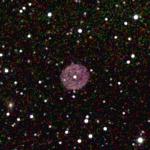 Atlas Image mosaic of the little-studied planetary nebula NGC 1501,
which is at roughly a
distance of 1.3 kpc (4238 light years) from us. The pinkish-purplish
nebula surrounds a very hot central star, which has a temperature
of nearly 90,000 K. The morphology of the nebula appears to be
affected by the vigorous wind from the star (Sabbadin et al. 2000, A&A, 361,
1112). Planetary nebulae are formed as stars, like our Sun, reach the
end of their lives and lose their outer envelopes to the interstellar medium.
The hot central star, originally the core of the dying star, which will
eventually become a white dwarf and cool off over billions of years.
(Field size 5.0´ × 5.0´. Image size 136 kb.)
Atlas Image mosaic of the little-studied planetary nebula NGC 1501,
which is at roughly a
distance of 1.3 kpc (4238 light years) from us. The pinkish-purplish
nebula surrounds a very hot central star, which has a temperature
of nearly 90,000 K. The morphology of the nebula appears to be
affected by the vigorous wind from the star (Sabbadin et al. 2000, A&A, 361,
1112). Planetary nebulae are formed as stars, like our Sun, reach the
end of their lives and lose their outer envelopes to the interstellar medium.
The hot central star, originally the core of the dying star, which will
eventually become a white dwarf and cool off over billions of years.
(Field size 5.0´ × 5.0´. Image size 136 kb.)
 The planetary nebula NGC 1514.
(Field size 5.5´ × 5.5´. Image size 160 kb.)
The planetary nebula NGC 1514.
(Field size 5.5´ × 5.5´. Image size 160 kb.)
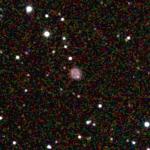 Atlas Image of NGC 2022, a planetary nebula having a small ring-like,
or elliptical, appearance. This nebula was previously imaged in the
near-infrared by
Latter et al. (1995, ApJS, 100, 159). From infrared spectra Hora, Latter, &
Deutsch (1999, ApJS, 124, 195) find that the light from NGC 2022 is dominated
by emission lines of neutral hydrogen. Planetary nebulae are formed as stars,
like our Sun, reach the end of their lives and lose their outer envelopes to
the interstellar medium. The hot central star (which can be faintly seen in the
2MASS image toward the center of the reddish ring), originally the core of the
dying star, which will eventually become a white dwarf and
cool off over billions of years.
(Field size 5´ × 5´. Image size 137 kb.)
Atlas Image of NGC 2022, a planetary nebula having a small ring-like,
or elliptical, appearance. This nebula was previously imaged in the
near-infrared by
Latter et al. (1995, ApJS, 100, 159). From infrared spectra Hora, Latter, &
Deutsch (1999, ApJS, 124, 195) find that the light from NGC 2022 is dominated
by emission lines of neutral hydrogen. Planetary nebulae are formed as stars,
like our Sun, reach the end of their lives and lose their outer envelopes to
the interstellar medium. The hot central star (which can be faintly seen in the
2MASS image toward the center of the reddish ring), originally the core of the
dying star, which will eventually become a white dwarf and
cool off over billions of years.
(Field size 5´ × 5´. Image size 137 kb.)
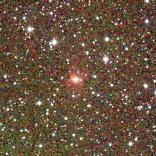 The bipolar planetary nebula NGC 2346
(Field size 9.5´ × 10.3´. Image size 438 kb.)
The bipolar planetary nebula NGC 2346
(Field size 9.5´ × 10.3´. Image size 438 kb.)
 The planetary nebula NGC 2371
(Field size 5.0´ × 5.0´. Image size 145 kb.)
The planetary nebula NGC 2371
(Field size 5.0´ × 5.0´. Image size 145 kb.)
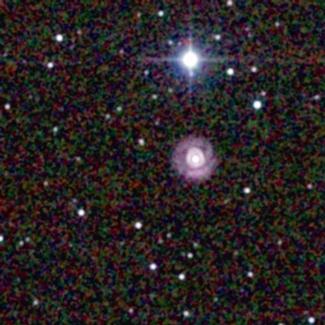 Atlas Image of the Eskimo Nebula (NGC 2392). This is a planetary
nebula, showing a double ring
structure. Planetary nebulae are formed as low-mass stars, like the Sun,
reach the end of their lives and lose their outer envelopes to the interstellar
medium. From an analysis of the nebula's kinematics, O'Dell, Weiner, &
Chu (1990, ApJ, 362, 226) proposed a model where the observer is looking
into a bipolar stellar wind flow from the hot central star (seen in the image
brightly at the nebula's center). The star first lost mass during the extended
red giant envelope stage from the equator of the precursor star, forming the
outer disk, or ring, ~5300 yr ago;
the inner disk, or ring, with an age of ~1000 yr, represents a more recent,
strong, ongoing wind. The central star will eventually evolve to a
white dwarf, as the nebular gas dissipates. Latter et al. (1995, ApJS, 100,
159) previously imaged the Eskimo in the near-infrared; in the case of this
nebula, the near-IR emission is dominated by reradiated light from the central
star by nebular dust
likely formed during the precursor star's asymptotic giant branch phase.
These data are part of the Spring 1999 data release.
(Field size 5.4´ × 5.4´. Image size 145 kb.)
Atlas Image of the Eskimo Nebula (NGC 2392). This is a planetary
nebula, showing a double ring
structure. Planetary nebulae are formed as low-mass stars, like the Sun,
reach the end of their lives and lose their outer envelopes to the interstellar
medium. From an analysis of the nebula's kinematics, O'Dell, Weiner, &
Chu (1990, ApJ, 362, 226) proposed a model where the observer is looking
into a bipolar stellar wind flow from the hot central star (seen in the image
brightly at the nebula's center). The star first lost mass during the extended
red giant envelope stage from the equator of the precursor star, forming the
outer disk, or ring, ~5300 yr ago;
the inner disk, or ring, with an age of ~1000 yr, represents a more recent,
strong, ongoing wind. The central star will eventually evolve to a
white dwarf, as the nebular gas dissipates. Latter et al. (1995, ApJS, 100,
159) previously imaged the Eskimo in the near-infrared; in the case of this
nebula, the near-IR emission is dominated by reradiated light from the central
star by nebular dust
likely formed during the precursor star's asymptotic giant branch phase.
These data are part of the Spring 1999 data release.
(Field size 5.4´ × 5.4´. Image size 145 kb.)
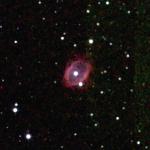 Atlas Image mosaic of the planetary nebula NGC
3132, known to amateur astronomers as the "Eight-Burst" or "Southern Ring"
Nebula. The nebula was spectacularly imaged in the optical in a number of
bands by the
Hubble Space Telescope. The large wind-blown cavity in the nebula is
also obvious in the near-infrared 2MASS image, as is much of the filamentary
structure and extended emission. In the near-infrared most of the emission
from NGC 3132 appears in the Ks (2.17 µm) band, giving the
planetary nebula the reddish color in the image. Planetary nebulae are formed
as low-mass stars, like our Sun, reach the end of their lives and lose their
outer envelopes to the interstellar medium. The bright source within the
nebula is the hot central star, originally the core of the dying star, which
will eventually become a white dwarf and cool off over billions of years.
Image mosaic by S. Van Dyk (IPAC).
(Field size 5.0´ × 5.0´. Image size 120 kb.)
Atlas Image mosaic of the planetary nebula NGC
3132, known to amateur astronomers as the "Eight-Burst" or "Southern Ring"
Nebula. The nebula was spectacularly imaged in the optical in a number of
bands by the
Hubble Space Telescope. The large wind-blown cavity in the nebula is
also obvious in the near-infrared 2MASS image, as is much of the filamentary
structure and extended emission. In the near-infrared most of the emission
from NGC 3132 appears in the Ks (2.17 µm) band, giving the
planetary nebula the reddish color in the image. Planetary nebulae are formed
as low-mass stars, like our Sun, reach the end of their lives and lose their
outer envelopes to the interstellar medium. The bright source within the
nebula is the hot central star, originally the core of the dying star, which
will eventually become a white dwarf and cool off over billions of years.
Image mosaic by S. Van Dyk (IPAC).
(Field size 5.0´ × 5.0´. Image size 120 kb.)
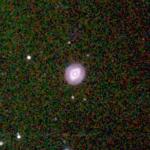 Atlas Image of the planetary nebula NGC 3242.
This nebula has an elliptical shape and several interesting structural
features,
including the inner bright elliptical ring, the two extensions to the ring,
or ansae, that are placed roughly along the major axis of
the elliptical emission, and the larger faint halo that envelops the inner
structure (Hora, Latter, & Deutsch 1999, ApJS, 124, 195). The bright ring
is pure continuum emission, while the faint halo is (dust) scattered light.
Planetary nebulae are formed as low-mass stars, like our Sun, reach the end of
their lives and lose their outer envelopes (for this nebula, what are now the
ring and halo structures) to the interstellar medium.
The bright source within the bright elliptical ring is the hot central star of
the planetary nebula, originally the core of the dying star, which will
eventually become a white dwarf and cool off over billions of years.
These data are included in the Second Incremental Release!
(Field size 5.0´ × 5.0´. Image size 130 kb.)
Atlas Image of the planetary nebula NGC 3242.
This nebula has an elliptical shape and several interesting structural
features,
including the inner bright elliptical ring, the two extensions to the ring,
or ansae, that are placed roughly along the major axis of
the elliptical emission, and the larger faint halo that envelops the inner
structure (Hora, Latter, & Deutsch 1999, ApJS, 124, 195). The bright ring
is pure continuum emission, while the faint halo is (dust) scattered light.
Planetary nebulae are formed as low-mass stars, like our Sun, reach the end of
their lives and lose their outer envelopes (for this nebula, what are now the
ring and halo structures) to the interstellar medium.
The bright source within the bright elliptical ring is the hot central star of
the planetary nebula, originally the core of the dying star, which will
eventually become a white dwarf and cool off over billions of years.
These data are included in the Second Incremental Release!
(Field size 5.0´ × 5.0´. Image size 130 kb.)
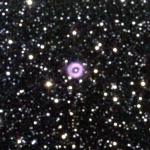 Atlas Image mosaic of the planetary nebula
NGC 6369. The nebula,
noted for its peculiar fishtail-like outer loop morphology in
the light of optical emission lines (also seen faintly in this near-infrared
image, outside the bright ring of the nebula). This planetary nebula
is associated with fast low-ionization
emission regions, or FLIERs, which are thought to be discrete, collimated,
and highly supersonic ejection events from the very hot central star
(Hajian 1997, ApJ, 487, 304), which can be seen at the center of the ring.
Planetary nebulae are formed as low-mass stars, like our Sun, reach the end of
their lives and lose their outer envelopes to the interstellar medium.
The pinkish color in the bright ring of the nebula may arise from emission by
atomic and molecular hydrogen primarily in the 2.17 µm wavelength
(Ks) band, or dust scattering in a combination of all three bands.
These data are included in the Second Incremental Release!
(Field size 5.0´ × 5.0´. Image size 120 kb.)
Atlas Image mosaic of the planetary nebula
NGC 6369. The nebula,
noted for its peculiar fishtail-like outer loop morphology in
the light of optical emission lines (also seen faintly in this near-infrared
image, outside the bright ring of the nebula). This planetary nebula
is associated with fast low-ionization
emission regions, or FLIERs, which are thought to be discrete, collimated,
and highly supersonic ejection events from the very hot central star
(Hajian 1997, ApJ, 487, 304), which can be seen at the center of the ring.
Planetary nebulae are formed as low-mass stars, like our Sun, reach the end of
their lives and lose their outer envelopes to the interstellar medium.
The pinkish color in the bright ring of the nebula may arise from emission by
atomic and molecular hydrogen primarily in the 2.17 µm wavelength
(Ks) band, or dust scattering in a combination of all three bands.
These data are included in the Second Incremental Release!
(Field size 5.0´ × 5.0´. Image size 120 kb.)
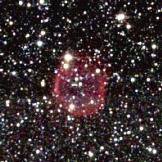 Atlas Image mosaic of the planetary nebula NGC 6781.
Planetary nebulae (PNe) are formed as low-mass stars, like the Sun, reach the
end of their lives and lose their outer envelopes to the interstellar medium.
NGC 6781 has a very similar "ring-like" morphology to the famous PN, the
Ring Nebula (M57). The red glow of NGC 6781's
ring in the near-infrared is due to 2.12 µm emission from molecular
hydrogen (H2), which is strong in the 2MASS Ks band.
Although the main ring is quite bright, the fainter H2 filaments
within and halo emission outside of the bright ring, as studied by Kastner et
al. (1994, ApJ, 421, 600), can just barely be seen in the 2MASS image. Kastner
et al. postulate that if all PNe showing axial symmetry, and therefore,
possessing bipolar structure, are H2-bright, as first found by
Zuckerman & Gatley (1988, ApJ, 324, 501), then ring-like PNe, like
NGC 6781, with strong shocked H2 emission may be bipolar nebulae
viewed with an inclined polar axis with respect to the plane of the sky. The
bright ring is the equatorial torus, from a high-density slow wind from the
evolving star, whereas the fainter halo structures are the polar lobes and the
remnants of a faster, low-density wind. For NGC 6781 the lobe geometry may be
a bipolar cylinder with half the radius of and within the bright torus.
Near-infrared observations, such as those by 2MASS, provide very important
information about PNe and the evolution of stars like our Sun.
(Field size 6.0´ × 6.0´. Image size 176 kb.)
Atlas Image mosaic of the planetary nebula NGC 6781.
Planetary nebulae (PNe) are formed as low-mass stars, like the Sun, reach the
end of their lives and lose their outer envelopes to the interstellar medium.
NGC 6781 has a very similar "ring-like" morphology to the famous PN, the
Ring Nebula (M57). The red glow of NGC 6781's
ring in the near-infrared is due to 2.12 µm emission from molecular
hydrogen (H2), which is strong in the 2MASS Ks band.
Although the main ring is quite bright, the fainter H2 filaments
within and halo emission outside of the bright ring, as studied by Kastner et
al. (1994, ApJ, 421, 600), can just barely be seen in the 2MASS image. Kastner
et al. postulate that if all PNe showing axial symmetry, and therefore,
possessing bipolar structure, are H2-bright, as first found by
Zuckerman & Gatley (1988, ApJ, 324, 501), then ring-like PNe, like
NGC 6781, with strong shocked H2 emission may be bipolar nebulae
viewed with an inclined polar axis with respect to the plane of the sky. The
bright ring is the equatorial torus, from a high-density slow wind from the
evolving star, whereas the fainter halo structures are the polar lobes and the
remnants of a faster, low-density wind. For NGC 6781 the lobe geometry may be
a bipolar cylinder with half the radius of and within the bright torus.
Near-infrared observations, such as those by 2MASS, provide very important
information about PNe and the evolution of stars like our Sun.
(Field size 6.0´ × 6.0´. Image size 176 kb.)
 The planetary nebula NGC 6818.
(Field size 4.5´ × 4.5´. Image size 106 kb.)
The planetary nebula NGC 6818.
(Field size 4.5´ × 4.5´. Image size 106 kb.)
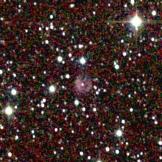 The planetary nebula NGC 6905. This planetary nebula belongs to the
small group of very high excitation objects, with Teff > 100000 K
(Feibelman
1996, ApJ, 472, 294). The near-IR emission seen in this image is likely
from molecular hydrogen. The central star is also visible, as it is in the
optical images in Balick (1987, AJ, 94, 671).
(This composite image was made early in the
survey, when focus was not yet quite optimal.)
(Field size 5.4´ × 5.7´. Image size 165 kb.)
The planetary nebula NGC 6905. This planetary nebula belongs to the
small group of very high excitation objects, with Teff > 100000 K
(Feibelman
1996, ApJ, 472, 294). The near-IR emission seen in this image is likely
from molecular hydrogen. The central star is also visible, as it is in the
optical images in Balick (1987, AJ, 94, 671).
(This composite image was made early in the
survey, when focus was not yet quite optimal.)
(Field size 5.4´ × 5.7´. Image size 165 kb.)
 Atlas Image of the Butterfly Nebula. The Butterfly, also known as M 2-9 and
IRAS 17028-1004, is thought to be a young planetary nebula, which
is the final stage of evolution for stars similar to our Sun. It has
a distinctly bipolar structure, evident in the 2MASS image, with a
bright central star. (The red "star" directly to the south of the
nebula's central star is a known persistence artifact of the infrared-bright
star; diffraction spike artifacts are also seen emanating from the bright
star.) The star has an optical spectrum of late O- or early B-type, hot
enough to ionize the gas in the two bipolar lobes, but it is clear from the
star's high brightness in the Ks band that we are more likely seeing
emission from a region of concentrated light scattering to the infrared,
directly around the star. Within the lobes are a number of knots. The knots
emit strongly in the [Fe II] lines, indicating high temperature shocks; in
the lobes light is also primarily emitted by hydrogen recombination and
continuum light scattering from the central star (Hora & Latter 1994, ApJ, 437,
281). The outer shell structure of the lobes is a well-defined
photodissociation region, as H2 is radiatively excited and emits
light at 2-2.5 µm. Studying fainter more extended lobes in the optical,
Schwarz et al. (1997, A&A, 319, 267) find a distance of ~650 pc and a
dynamical age for the nebula of ~1200 yr; they also argue that the central
source is a hot, compact possible binary star system. The Hubble Space
Telescope has also obtained an interesting
view
of this nebula.
(Field size 4.0´ × 4.0´. Image size 96 kb.)
Atlas Image of the Butterfly Nebula. The Butterfly, also known as M 2-9 and
IRAS 17028-1004, is thought to be a young planetary nebula, which
is the final stage of evolution for stars similar to our Sun. It has
a distinctly bipolar structure, evident in the 2MASS image, with a
bright central star. (The red "star" directly to the south of the
nebula's central star is a known persistence artifact of the infrared-bright
star; diffraction spike artifacts are also seen emanating from the bright
star.) The star has an optical spectrum of late O- or early B-type, hot
enough to ionize the gas in the two bipolar lobes, but it is clear from the
star's high brightness in the Ks band that we are more likely seeing
emission from a region of concentrated light scattering to the infrared,
directly around the star. Within the lobes are a number of knots. The knots
emit strongly in the [Fe II] lines, indicating high temperature shocks; in
the lobes light is also primarily emitted by hydrogen recombination and
continuum light scattering from the central star (Hora & Latter 1994, ApJ, 437,
281). The outer shell structure of the lobes is a well-defined
photodissociation region, as H2 is radiatively excited and emits
light at 2-2.5 µm. Studying fainter more extended lobes in the optical,
Schwarz et al. (1997, A&A, 319, 267) find a distance of ~650 pc and a
dynamical age for the nebula of ~1200 yr; they also argue that the central
source is a hot, compact possible binary star system. The Hubble Space
Telescope has also obtained an interesting
view
of this nebula.
(Field size 4.0´ × 4.0´. Image size 96 kb.)
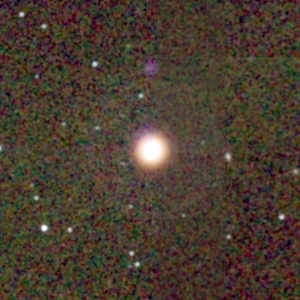 The planetary nebula IC 418.
(Field size 5.0´ × 5.0´. Image size 129 kb.)
The planetary nebula IC 418.
(Field size 5.0´ × 5.0´. Image size 129 kb.)
Return to 2MASS Image Gallery Homepage